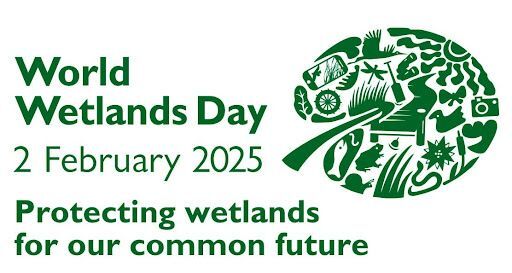
World Wetland Day
Every year on February 2nd, we celebrate World Wetlands Day to raise awareness about the importance of wetlands. World Wetlands Day was established in 2021 by the UN general assembly. This year's theme is "Protecting Wetlands for Our Common Future," so let's take a look at Nebraska's amazing wetlands!
Wetlands in Nebraska
According to Nebraska Game and Parks Commission Wetland Program Manager, Ted LaGrange, wetlands are the most productive natural system in Nebraska. Wetlands are found in every county and are essential for our state’s natural resources.
They provide habitat for:
- 100% Nebraska’s amphibians
- 75% Nebraska’s endangered and threatened species
- 50% Nebraska’s birds
- 38% Nebraska’s reptiles
- 36% Nebraska’s mammals
What is a Wetland?
The three characteristics of wetlands are hydric soils, vegetation, and hydrology:
- Wetland soils are hydric, which means they are full of water, with little oxygen and a lot of organic matter.
- The plants that inhabit wetlands are adapted to live in anaerobic environments, or without oxygen.
- Hydrology means water saturation, but wetlands are not always saturated.
Nebraska contains more acres of wetlands than any surrounding state with an estimated 1.8 million acres across the state.
Why are Wetlands important?
Wetlands are crucial to Nebraska’s habitat and wildlife. They also improve water quality, prevent erosion, reduce flooding, store carbon dioxide, offer recreational opportunities, and provide benefits for livestock and agriculture.
The Sandhills
The Sandhills are a crucial part to not only Nebraska’s landscape, but to wetlands as well. The Sandhills contain the greatest density of wetlands in the state with over a million acres supported by the Ogallala Aquifer.
Types of Wetlands in Nebraska
Nebraska is home to 4 main types of wetlands: Playa, Riverine, Saline/Alkaline, Sandhills, but a honorary category is Urban because wetlands are everywhere in Nebraska.
- Playa Wetlands: characterized by circular depressions that collect rainfall.
- Riverine Wetlands: found along rivers, streams and floodplains.
- Saline/Alkaline Wetlands: contain salty minerals.
- Sandhills Wetlands: located in the Sandhills region of Nebraska, mainly along rivers.
- Urban Wetlands: located in cities and towns, and benefit both people and wildlife.
Wildlife in Wetlands
Wetlands are critically important ecosystems and are home to a variety of species. One of the most notable being the waterfowl and birds- with 80% of Sandhill Cranes going through the Platte River and its surrounding wetlands on their migration.
Another crucial inhabitant of the wetlands is the Salt Creek tiger beetle. This beetle is only found in the Eastern Saline wetlands, which is the last habitat in the world to support it. The Eastern Saline wetlands are located in and around Lincoln and Lancaster County. The Salt Creek tiger beetle is a state and federally listed endangered species, so the conservation of its habitat is vital.
Wetland Conservation
Sadly, over the last 200 years, Nebraska experienced a 35% decrease in wetland acres from 2.9 million to 1.9 million, primarily due to human development. Other threats include drainage, filling, degradation, conversion to agricultural use, transportation, water pollution, and invasive plants. All of these practices result in alteration or destruction of wetlands.
Different organizations like Nebraska Game and Parks Commissions and the Platte River Basin Environments are working to preserve, conserve, enhance, and restore these vital wildlife habitats and natural areas. As well as, different regulations and community planning to prevent development in or near wetland ecosystems.
The Nebraska Game and Parks Commission has partnered with Platte Basin Timelapse to develop a series of videos about wetlands resources. These videos showcase the importance and dynamics of Nebraska’s wetlands and take an in-depth look at Nebraska’s regional wetland complexes.
If you want to learn more about how wetlands are a resilient ecosystem attend our virtual event on Thursday, February 13th from 6-7 pm over Zoom. This event will explore the role of disturbances in enhancing Nebraska's wetland ecosystems with speaker Ted LaGrange- Wetland Program Manager with Nebraska Game and Parks commission.
Thank you for learning about Nebraska’s wetlands.
Check out our past wetland programs on YouTube to learn more:
- Exploring the Amazing Diversity of Wetlands in Nebraska
- World Wetland’s Day Celebration 2022
- World Wetlands Day: Lincoln, Nebraska’s Legacy
- Restoring Eastern Nebraska's Saline Wetlands
- Wild Places: The Importance of Wetlands
Follow Along:
YouTube: https://www.youtube.com/@conservationnebraska
Facebook: https://www.facebook.com/ConservationNebraska
Instagram: https://www.instagram.com/conservationnebraska/
X: https://x.com/ConservationNE

